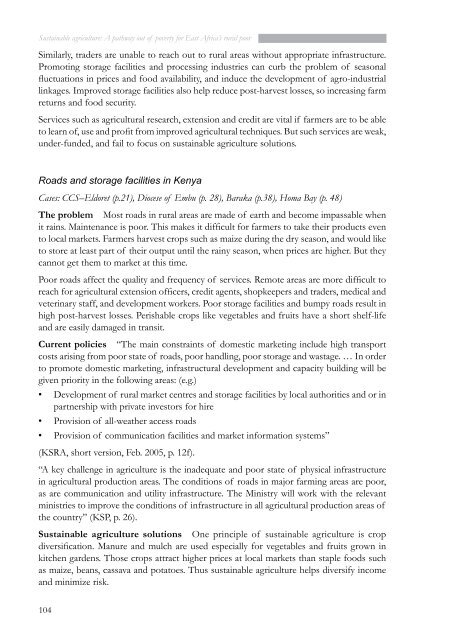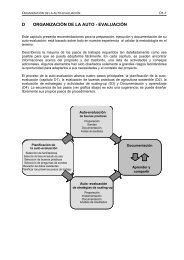cases from tanzania - Sustainet
cases from tanzania - Sustainet
cases from tanzania - Sustainet
You also want an ePaper? Increase the reach of your titles
YUMPU automatically turns print PDFs into web optimized ePapers that Google loves.
Sustainable agriculture: A pathway out of poverty for East Africa’s rural poor<br />
Similarly, traders are unable to reach out to rural areas without appropriate infrastructure.<br />
Promoting storage facilities and processing industries can curb the problem of seasonal<br />
fluctuations in prices and food availability, and induce the development of agro-industrial<br />
linkages. Improved storage facilities also help reduce post-harvest losses, so increasing farm<br />
returns and food security.<br />
Services such as agricultural research, extension and credit are vital if farmers are to be able<br />
to learn of, use and profit <strong>from</strong> improved agricultural techniques. But such services are weak,<br />
under-funded, and fail to focus on sustainable agriculture solutions.<br />
Roads and storage facilities in Kenya<br />
Cases: CCS–Eldoret (p.21), Diocese of Embu (p. 28), Baraka (p.38), Homa Bay (p. 48)<br />
The problem Most roads in rural areas are made of earth and become impassable when<br />
it rains. Maintenance is poor. This makes it difficult for farmers to take their products even<br />
to local markets. Farmers harvest crops such as maize during the dry season, and would like<br />
to store at least part of their output until the rainy season, when prices are higher. But they<br />
cannot get them to market at this time.<br />
Poor roads affect the quality and frequency of services. Remote areas are more difficult to<br />
reach for agricultural extension officers, credit agents, shopkeepers and traders, medical and<br />
veterinary staff, and development workers. Poor storage facilities and bumpy roads result in<br />
high post-harvest losses. Perishable crops like vegetables and fruits have a short shelf-life<br />
and are easily damaged in transit.<br />
Current policies “The main constraints of domestic marketing include high transport<br />
costs arising <strong>from</strong> poor state of roads, poor handling, poor storage and wastage. … In order<br />
to promote domestic marketing, infrastructural development and capacity building will be<br />
given priority in the following areas: (e.g.)<br />
• Development of rural market centres and storage facilities by local authorities and or in<br />
partnership with private investors for hire<br />
• Provision of all-weather access roads<br />
• Provision of communication facilities and market information systems”<br />
(KSRA, short version, Feb. 2005, p. 12f).<br />
“A key challenge in agriculture is the inadequate and poor state of physical infrastructure<br />
in agricultural production areas. The conditions of roads in major farming areas are poor,<br />
as are communication and utility infrastructure. The Ministry will work with the relevant<br />
ministries to improve the conditions of infrastructure in all agricultural production areas of<br />
the country” (KSP, p. 26).<br />
Sustainable agriculture solutions One principle of sustainable agriculture is crop<br />
diversification. Manure and mulch are used especially for vegetables and fruits grown in<br />
kitchen gardens. Those crops attract higher prices at local markets than staple foods such<br />
as maize, beans, cassava and potatoes. Thus sustainable agriculture helps diversify income<br />
and minimize risk.<br />
104




